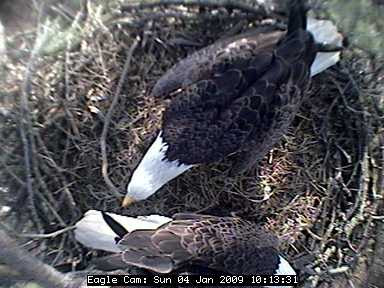.JPG) Sunrise at the St. Sebastian River Buffer Preserve
Sunrise at the St. Sebastian River Buffer PreserveDriving in the chilly 40 degree morning at the ungodly hour of 3:30am to get to the bus zone for my first field trip at the Space Coast Bird and Wildlife Festival, I couldn't help but think how crazy birders are for putting up with such early morning calls. However, if it will take the bus an hour to get to the site where the elusive red-cockaded woodpecker will briefly appear at the beginning of his day, you bite the bullet and make the sacrifice.
It turned out to be no sacrifice at all and well worth the effort. The bus was 40 minutes late (damn, I could have slept some more!) but we all grabbed some shuteye on the trip out to the St. Sebastian River Buffer Preserve where 8 clusters (family units) of red cockadeds are established. The staff at the Preserve have translocated another 5 pairs hoping that when breeding season comes around in March and April, that they will stay and increase the number of clusters to 13.
It turned out to be no sacrifice at all and well worth the effort. The bus was 40 minutes late (damn, I could have slept some more!) but we all grabbed some shuteye on the trip out to the St. Sebastian River Buffer Preserve where 8 clusters (family units) of red cockadeds are established. The staff at the Preserve have translocated another 5 pairs hoping that when breeding season comes around in March and April, that they will stay and increase the number of clusters to 13.

An active nesting cavity tree (note the spray painted circle)
White spray-painted circles mark the trees where active nesting cavities are. Red cockadeds singly inhabit a cavity and they are meticulous house builders and housekeepers. The woodpeckers instinctively know which live pine trees are infected with a disease that makes the wood softer and easier to drill into. However, the tree must reach an average age of 70-80 years before the disease takes hold, so clearcutting and logging have destroyed important habitat that is taking decades to reforest. Clutches of eggs are laid in the male's cavity while both parents as well as "helper" birds - usually males from previous clutches - all participate in feeding. It truly takes a village to raise red cockadeds. The females tend to leave the cluster and make a love connection with other males to start new clusters. The woodpeckers drill holes all around the nest cavity to make the resin run and deter predator rat snakes. Active management in the form of chick banding and the very successful human-built nest cavities as well as translocation and habitat preservation (with
controlled burns) have helped rebuild the population slightly.
.JPG) Jeff Gordon searching for red cockaded woodpeckers
Jeff Gordon searching for red cockaded woodpeckersAfter trudging through knee-high saw palemettos and grass coated with dew, we came to a trio of active cavity trees and waited. As the sun rose over the horizon, two red cockadeds came out of their cavities to greet the morning and us. What awesome views of such a difficult-to-find bird - found in only 11 states and with only an estimated 6,100 clusters.
Jeff Gordon, tour guide extraordinaire, called in a Bachman's sparrow (another life bird for me), but I couldn't get good enough looks at this tiny skulking bird to count it. We returned to the trucks (we were sitting on hay bales in the back of several pickup trucks) and right by the truck was a Bachman's perched high on a shrub singing his heart out. Great looks in Jeff's scope gave me a view of a life bird that is certainly hard to come by.
Traveling by birder-hayride to another part of the Preserve, we got great looks at Florida scrub jays - funny, engaging and vocal birds. Socially gregarious and breeding in family groups, the scrub jay is the more important species to the St. Sebastian River Buffer Preserve. The Preserve hosts 70-80 scrubjays (in 39 family groups) but has room for up to 125. The Preserve is the fourth largest collection of scrubjays in the state. Disappearing habitat is responsible for their decline.
We left the St. Sebastian River Buffer Preserve to head over to the Marsh Landing Restaurant for brunch. Fortified with corned beef hash and eggs as well as four life birds, I was ready for the next leg of the trip - the T.M. Goodwin Waterfowl Management Area. There I collected an additional 14 life birds!!! More on that tomorrow.
Today's birds from the St. Sebastian Preserve (life birds are in bold):
Red Cockaded Woodpecker
Pine Warbler
Great Egret
Bachman's Sparrow
Eastern Towhee
Yellow-bellied Sapsucker
American Kestrel
Eastern Phoebe
Yellow-rumped Warbler
Loggerhead Shrike
American Robin
Gray Catbird
Florida Scrub Jay
Eastern Meadowlark





